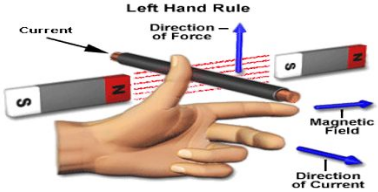Fleming’s left and right hand rules were first discovered and described by John Ambrose Fleming in 19th century. These rules try to explain the relationship between magnetic field, the current and force. These rules only show the direction and do not determine the magnitude of magnetic field, current and force. In practice, Fleming’s Left Hand rule is mainly applied to electric motors whereas Fleming’s Right Hand rule is mainly applied to electric generators.
Fleming’s Left Hand Rule
Whenever a current carrying conductor is placed inside a magnetic field, there will be a force acting on the conductor. The direction of this force can be described using Fleming’s Left Hand Rule, also referred to as Fleming’s Left Hand Rule For Motors.
Through the rule, it is found that a force acts on the current carrying conductor in a direction perpendicular to both the directions of the current and the magnetic field.
The rule states that’’ Hold out your left hand with the first finger, second finger and thumb at the right angle to one another. The first finger represents the direction of the field, the second finger represents the direction of current and the thumb represents the thrust on the conductor (direction of force).

What You Need To Know About Fleming’s Left Hand Rule
- Discovered by John Ambrose Fleming
- It is used for electric motors
- The main purpose of left hand rule is to show the direction of motion in an electric motor.
- The first finger represents the direction of the magnetic field.
- Second finger/ the middle finger represent the direction of the current.
- The thumb represents the direction of the Thrust on the conductor/motion of the conductor.
Fleming’s Right Hand Rule
Whenever a conductor is placed inside a magnetic field, there will be an induced current in that conductor. If this current carrying conductor gets forcefully moved inside the magnetic field, there will be a relationship between the direction of applied force, current and magnetic field. The relationship among the three parameters can be explained using Fleming’s Right Hand Rule also referred to as Fleming’s Right Hand Rule For Generators.
Through the rule, it is found that a force acts on the current carrying conductor in a direction perpendicular to both the directions of the current and the magnetic field.
This rule states that “Hold out the right hand with the first finger, second finger and thumb at the right angle to each other. The first finger represents the direction of line of force, the thumb points in the direction of motion or applied force, then the second finger points in the direction of the induced current’’
What You Need To Know Fleming’s Right Hand Rule
- Discovered by John Ambrose Fleming
- Used for generators
- The main purpose of the right hand rule is to show the direction of induced current when a conductor moves in a magnetic field.
- The first finger represents the direction of the magnetic field.
- The second/middle finger represents the direction of the induced current or generated current. The direction of the induced current will be the direction of conventional current, from positive to negative.
- The thumb represents the direction of motion of the conductor.
Also Read: Difference Between Conductor, Insulator And Semi-Conductor
Best Way To Remember Fleming’s Left And Right Hand Rule: Difference In Tabular Form
| BASIS OF COMPARISON | LEFT HAND RULE | RIGHT HAND RULE |
| Discovery | Discovered by John Ambrose Fleming | Discovered by John Ambrose Fleming |
| Application | Used for Motors | Used for generators |
| Main Purpose | The main purpose of left hand rule is to show the direction of motion in an electric motor. | The main purpose of the right hand rule is to show the direction of induced current when a conductor moves in a magnetic field. |
| First Finger/Forefinger | The first finger represents the direction of the magnetic field. | The first finger represents the direction of the magnetic field. |
| Second finger/ The middle finger | Second finger/ the middle finger represent the direction of the current. | The second/middle finger represents the direction of the induced current or generated current. The direction of the induced current will be the direction of conventional current, from positive to negative. |
| Thumb | The thumb represents the direction of the Thrust on the conductor/motion of the conductor. | The thumb represents the direction of motion of the conductor. |
Also Read: Difference Between P-type And N-type Semiconductor